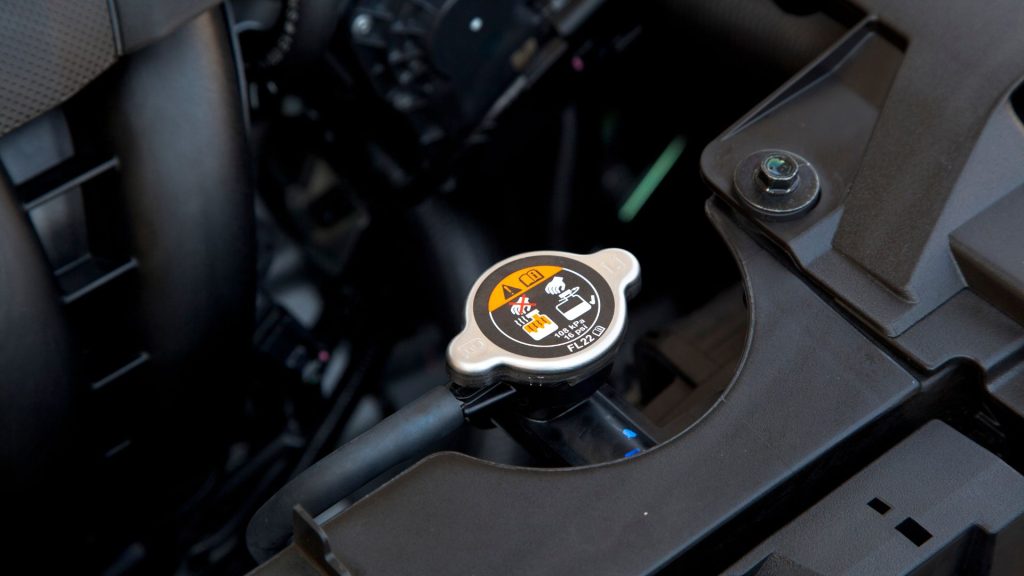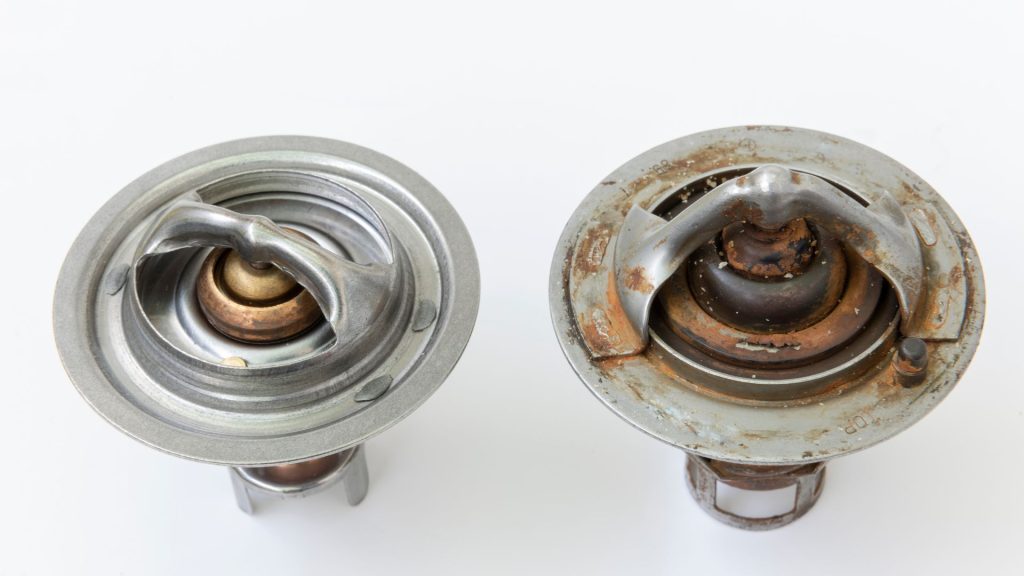This paper in the International Research Journal of Engineering and Technology blames the Ford company for introducing the radiator. Or, at the very least, they were among the first to research the concept.
Now every vehicle uses a radiator and coolant. To understand why coolant won’t drain back into the radiator, you need to know how the cooling system works. That means keeping the following in mind:
- Cars use a controlled exposition to run. But one paper in the International Journal of Recent Technology and Engineering noted that only 35 percent of a fuel’s energy drives the vehicle. 35 percent becomes exhaust gases. You also have an additional 30 percent that your car’s cooling system eliminates as heat.
- The radiator is vital to the cooling system because it uses the coolant to disperse the heat. Manufacturers use aluminum to make the radiator.
- The cap is just as important as the radiator. Besides protecting the cooling system from contaminants, it allows coolant to move to the overflow tank when the pressure expands.
- Speaking of the coolant, it stores the excess heat the engine generates. Without the coolant, your vehicle would overheat.
- The thermostat allows the coolant to flow in response to high temperatures. A functional thermostat will open when the temperature is too high and close when the temperature drops.
- The water pump circulates the coolant between the engine and the radiator.
- The head gasket keeps the coolant and oil in separate passageways, preventing them from mixing.
- The hoses create passageways through which the coolant can flow.
How does the coolant reservoir fit into this system? According to experts from the Department of Mechanical Engineering, RMCET, Maharashtra, India, the reservoir prevents the coolant from falling to dangerous levels by holding additional coolant.
This is how things work. The car will draw coolant from the reservoir when the coolant in the system is too low. But what if the pressure is too high? The reverse will happen. The coolant will flow back into the overflow.
Keep in mind that coolant flows through a closed system. Therefore, the coolant amount remains largely unchanged. Additionally, it shouldn’t overheat. When the temperature increases dramatically, the coolant expands, which is a problem because it can create a leak.
The reservoir prevents this outcome by providing a space for the expanding coolant to escape and cool. The coolant will stay there until the cooling system needs it. This raises a question. What if the coolant refuses to flow back into the radiator?
First of all, coolant doesn’t flow back into the radiator. Instead, the vehicle pulls the coolant out of the reservoir when needed. If the reservoir has coolant, but you can’t see any in the radiator, you should blame one or more of the following:
1). The Hose Is Blocked

Inspect the hose between the radiator and the overflow tank. Does it look kinked? Look for soft sections that tend to collapse. You should also check for clogging and tears. A leaking hose is just as problematic as its blocked and kinked counterpart.
2). The Cap Is Loose

The radiator cap does more than you think. Besides maintaining the cooling system’s pressure, it has a pressure spring that allows the coolant to transition to the reservoir by compressing. It will also permit the coolant to return to the radiator when it cools.
Northern Radiator has a picture revealing the different parts of a radiator cap, proving that it’s more complex than many laypeople realize. What happens when the cap is loose or if it develops defects? The coolant won’t drain back to the radiator.
3). The Thermostat Is Stuck

You wouldn’t be wrong in calling the thermostat the rudder. It responds to high or low temperatures by opening or closing. Therefore, it can allow the coolant to flow or prohibit it. What happens when the thermostat sticks in the closed position? The coolant won’t flow. The reservoir may overflow as a result.
4). The Radiator Is Blocked

The radiator is susceptible to various obstructions. For instance, sediment and rust can build up in the tubes. This will allow coolant to accumulate in the reservoir. It may even spill if you permit the blockage to persist.
5). You Have A leak

The coolant is leaking somewhere. Have you seen drops and puddles on the floor under the car? Is the coolant level lower than it should be? Leaks are annoying because it takes a while to find the culprit, especially when you rule out the hose.
Overheating may point to a blown gasket. A damaged gasket allows the coolant to escape into the cylinders. This assumes that you topped up the coolant. Coolant will deplete over time. And if you don’t refill it, the fluid will disappear completely.
If the reservoir is overflowing, you can check the thermostat, cap, hoses, and radiator. But if you can’t find coolant in the reservoir or radiator, you can’t rule out the possibility that you’re out of coolant.
What Are The Symptoms?
Cars are expressive. They won’t hesitate to let you know when coolant fails to drain back into the radiator. Look for the following symptoms:
- Without coolant in the system, the engine will overheat. The vehicle’s performance will suffer.
- You may notice smoke billowing from under the hood.
- The car may stop working altogether.
- You may notice the coolant on the floor under the car because of a leak.
- The ‘Check Engine’ light will come on and stay on.
- You may notice a sweet smell because of the leaking coolant.
Diagnosing And Fixing Coolant Reservoir That Doesn’t Drain Back Into Radiator
1). Check the hoses for blockages. You can use a blow nozzle from the compressor. It will make a blocked hose bulge. Remove the obstructions. If you can’t reach the blockage without damaging the hose, get a new hose.
2). You should also tighten the hose clamps to prevent leaks.
3). If the hose is pinched, remove the kinks.
4). If the hose has holes, replace it. Patching the holes is a temporary measure.
5). Check the radiator with a tester. Replace a defective cap. You can try tightening the cap or cleaning it before buying a new one. What does the manual say about proper cap replacement? Does the new cap match the old cap’s pressure? Don’t buy the wrong replacement cap.
6). If the coolant level is too low, add more coolant. Use the vehicle’s recommended brand to be on the safe side.
7). Replace a bad thermostat. A bad thermostat may cause the coolant to overflow.
8). If your gasket is blown, check the oil. Does it have a milky texture? What about the tailpipe? Do you see white smoke? Is the engine losing power? Is it overheating? You don’t fix head gaskets. Get a new one. These components are inexpensive.
9). If the reservoir is cracked or broken, replace it.
10). A defective water pump won’t let the coolant flow. You may see it on the ground. This should encourage you to replace the water pump.
11). If the radiator has blockages and contaminants, remove them. Some radiators are too far gone. You should replace yours, especially if you notice a leak.
12). Don’t be afraid to call an expert. If you can’t find the problem, take the car to a mechanic and let them resolve the issue.
How To Prevent Such Issues In The Future?
1). Perform regular maintenance. Make it a habit to check the section of the hose near the clamp. This is where it tends to degrade. Does the hose in this area feel soft and mushy when you squeeze it? If it isn’t firm and pliable, consider replacing it before things go wrong.
2). Keep an eye on the coolant and refill it as frequently as the manual or your mechanic recommends. Use the appropriate brand.
3). Search for leaks whenever you see drops and puddles of coolant on the ground under the car. Don’t wait for the leak to evolve into a bigger problem. Medical News Today has noted that antifreeze is toxic to people that ingest it. You don’t want the coolant to leak when you have young children in your home.
4). Make sure the radiator cap is tight.
5). Take the car to a mechanic whenever the ‘Check Engine’ light comes on and persists.
6). Toyota recommends flushing the coolant and replacing it every 30,000 miles.

